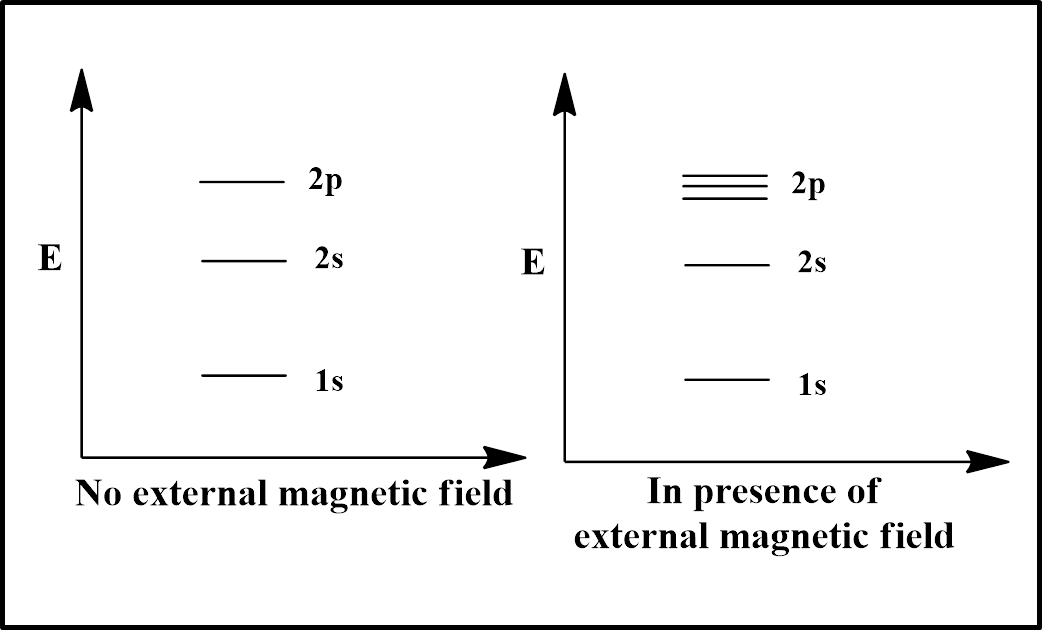
Zeeman effect explains the splitting of spectral lines in:
(A) Magnetic field
(B) Electric field
(C) Both A and B
(D) None of these
Answer
215.7k+ views
Hint: To attempt this question, compare the difference between the Zeeman effect and the Stark effect.
Complete step by step solution:
The spinning of an electron around the nucleus generates a magnetic dipole moment, denoted by the symbol “$\mu $”. As the electrons are negatively charged, the generated dipole moment points perpendicular to the area circumscribed by the spinning of the electron.
When an atom is placed in the presence of an external field which points along the z-axis, then the applied magnetic field creates a torque on the magnetic dipole moment created by the spinning of the electrons and will orient the torque along the z-axis.
${{\mu }_{z}}={{\mu }_{B}}\cdot {{m}_{l}}$, where${{\mu }_{B}}=$Bohr’s magneton and ${{m}_{l}}=$magnetic quantum number ($l$)
The orbitals of an atom have the skill to split in the presence of an external magnetic field and the number of the splits depends upon the orbital quantum number $l$.
Therefore, the number of splits $=(2l+1)$.

As the spectral splitting depends on magnetic quantum number ‘$l$” and s orbital have $l=0$, so there would be no splitting for s orbital (1s and 2s) as illustrated in the diagram. However, the $l$ value of p orbital is 1, so the 2p orbital will split into 3 splits ($=(2l+1)=(2\times 1+1)=(2+1)=3$).
Hence, the splitting of p orbitals and higher orbitals in an atom in the presence of the external magnetic field is known as the Zeeman effect. This effect is named after Pieter Zeeman (Dutch physicist).
Therefore, the Zeeman effect describes the splitting of spectral lines in presence of the magnetic field.
So, the correct answer is option (A).
Note: Analogous to Zeeman effect is the Stark effect, in which spectral lines splitting occurs in the presence of an external electric field. So, answer (B) would have been right in the case of the electric field.
Complete step by step solution:
The spinning of an electron around the nucleus generates a magnetic dipole moment, denoted by the symbol “$\mu $”. As the electrons are negatively charged, the generated dipole moment points perpendicular to the area circumscribed by the spinning of the electron.
When an atom is placed in the presence of an external field which points along the z-axis, then the applied magnetic field creates a torque on the magnetic dipole moment created by the spinning of the electrons and will orient the torque along the z-axis.
${{\mu }_{z}}={{\mu }_{B}}\cdot {{m}_{l}}$, where${{\mu }_{B}}=$Bohr’s magneton and ${{m}_{l}}=$magnetic quantum number ($l$)
The orbitals of an atom have the skill to split in the presence of an external magnetic field and the number of the splits depends upon the orbital quantum number $l$.
Therefore, the number of splits $=(2l+1)$.

As the spectral splitting depends on magnetic quantum number ‘$l$” and s orbital have $l=0$, so there would be no splitting for s orbital (1s and 2s) as illustrated in the diagram. However, the $l$ value of p orbital is 1, so the 2p orbital will split into 3 splits ($=(2l+1)=(2\times 1+1)=(2+1)=3$).
Hence, the splitting of p orbitals and higher orbitals in an atom in the presence of the external magnetic field is known as the Zeeman effect. This effect is named after Pieter Zeeman (Dutch physicist).
Therefore, the Zeeman effect describes the splitting of spectral lines in presence of the magnetic field.
So, the correct answer is option (A).
Note: Analogous to Zeeman effect is the Stark effect, in which spectral lines splitting occurs in the presence of an external electric field. So, answer (B) would have been right in the case of the electric field.
Recently Updated Pages
Alpha Particle Scattering and Rutherford Model Explained

Angle of Deviation in Prism: Formula, Explanation & Diagram

Angular Momentum of a Rotating Body: Definition & Formula

Apparent Frequency Explained: Formula, Uses & Examples

Applications of Echo in Daily Life and Science

Average and RMS Value Explained: Formulas & Examples

Trending doubts
JEE Main Correction Window 2026 Session 1 Dates Announced - Edit Form Details, Dates and Link

Atomic Structure: Definition, Models, and Examples

Alpha, Beta, and Gamma Decay Explained for JEE & NEET

Understanding Electromagnetic Waves and Their Importance

Geostationary and Geosynchronous Satellites Explained

Inertial and Non-Inertial Frame of Reference Explained

Other Pages
NCERT Solutions for Class 11 Chemistry Chapter Chapter 6 Equilibrium

Clemmensen and Wolff Kishner Reductions Explained for JEE & NEET

Organic Chemistry Some Basic Principles And Techniques Class 11 Chemistry Chapter 8 CBSE Notes - 2025-26

JEE Main 2023 January 29th Shift 2 Physics Question Paper with Answer Keys and Solutions

Current Loop as a Magnetic Dipole: Concept, Derivation, and Examples

NCERT Solutions For Class 11 Chemistry Chapter 1 Some Basic Concepts of Chemistry in Hindi - 2025-26




